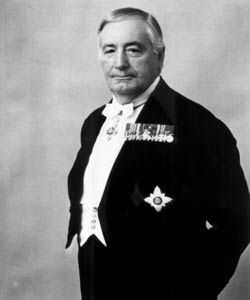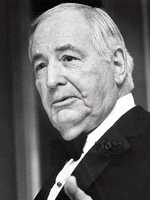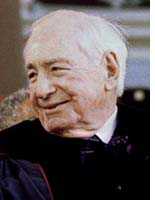|
As a media magnate
Walter Annenberg controlled important properties in the newspaper,
television, and magazine industries. Perhaps most significantly, he was
responsible for the creation of TV Guide, the largest circulation
weekly magazine in the world, a magazine central to understanding
television in America. He was also very active in the arena of American
politics, and served as United States Ambassador to the Court of St.
James. In his later life, Annenberg became renowned for his substantial
philanthropic activities, which included significant donations to
educational institutions and public television.
When his father was
imprisoned for tax evasion, Annenberg took over the family publishing
business. Triangle Publications, particularly The Daily Racing Form,
proved to be extremely profitable, and Annenberg looked for ways to
expand his company at precisely the time television was beginning to
emerge as America's communications medium of the future. Inspired by a
Philadelphia area television magazine called TV Digest, Annenberg
conceived the idea of publishing a national television feature magazine,
which he would then wrap around local television listings. The idea came
to fruition when Annenberg purchased TV Digest, along with the
similar publications TV Forecast from Chicago, and TV Guide
from New York. He combined their operations to form TV Guide in
1953, and quickly expanded the magazine by creating new regional
editions and purchasing existing television listings publications in
other markets.
Annenberg and his
aide, Merrill Panitt (who would go on to become TV Guide' s
editorial director), realized that in order achieve the circulation
necessary to make their publication a truly mass medium, they needed to
go beyond the fan magazine approach that had been typical of most
earlier television and radio periodicals. Because of this desire, they
created a magazine that was both a staunch booster of the American
system of television, yet at times also one of the most visible critics
of the medium's more egregious perceived shortcomings. TV Guide'
s editors often encouraged the magazine's readers to support quality
television programs struggling to gain an audience. In fact, TV Guide'
s greatest accomplishment under Annenberg may have been the magazine's
success in walking the fine line between encouraging and prodding the
medium to achieve its full potential without becoming too far removed
from the prevailing tastes of the mass viewing public. As a consequence,
TV Guide became extremely popular and widely read, and very
influential among those in the television industry. A large number of
distinguished authors wrote articles for the magazine over the years,
including such names as Margaret Mead, Betty Friedan, John Updike, Gore
Vidal, and Arthur Schlesinger, Jr. Many of these writers were attracted
by the lure of reaching TV Guide' s huge audience; at its peak in
the late 1970s, TV Guide had a paid circulation of nearly 20
million copies per week.
Annenberg remained
supportive of conservative political causes throughout the years, and
his efforts on behalf of Republicans were rewarded with his designation
by President Richard Nixon as U. S. Ambassador to Great Britain in 1969.
The appointment led Annenberg to sell his newspapers and television
stations, but he retained TV Guide and remained active in
managing the publication throughout his five-year tenure as Ambassador.
Shortly after the
election of his close friend, Ronald Reagan, as President in 1980 (he
would endorse Reagan's re-election campaign in 1984 in TV Guide,
the only such political endorsement ever to appear in the magazine),
Annenberg announced a plan to provide the Corporation for Public
Broadcasting with $150 million in funds over a fifteen year period to
produce educational television programs through which viewers could
obtain college credits. Annenberg's sympathy for educational causes had
already been evidenced by his financial support of the Annenberg Schools
of Communication at both the University of Pennsylvania and at the
University of Southern California. His activities in this regard would
grow even more pronounced in the years to come, particularly after his
sale of TV Guide and Triangle Publications to Rupert Murdoch's
News Corporation in 1988 for approximately $3 billion--at the time, the
largest price ever commanded for a publishing property.
Annenberg
continued to make news after his sale of Triangle because of his many
substantial donations to educational causes. In addition, Annenberg was
also one of the country's foremost collectors of art, and in 1991, he
bequeathed his extensive collection--valued at more than $1 billion--to
New York's Metropolitan Museum of Art. His post-Triangle era charitable
activities in the areas of education, art, and television served to
further assure Annenberg's lasting legacy to a wide spectrum of American
culture.
-David Gunzerath
|

Walter Annenberg
Photo courtesy of Walter Annenberg
WALTER H(UBERT) ANNENBERG. Born in Milwaukee, Wisconsin, 13 March
1908. Moved with family to Great Neck, Long Island, New York, 1920.
Educated at The Peddie School, Highstown, New Jersey, graduated 1927;
attended Wharton School of Finance, University of Pennsylvania,
Philadelphia, Pennsylvania, 1927-28. Married (1) Veronica Dunkelman,
1938 (divorced, 1950); children: Wallis, Roger (deceased); (2) Leonore
(Cohn) Rosentiel. Joined father, Moses Annenberg, successful publisher,
as assistant in the bookkeeping office, 1928; upon father's death, 1942,
assumed leadership of family business, Triangle Publications, Inc. which
included the Philadelphia (Pennsylvania) Inquirer, the Daily
Racing Form, the Morning Telegraph, and other minor
publications; founded Seventeen magazine, 1944; TV Guide,
1953; acquired the Philadelphia (Pennsylvania) Daily News, 1957;
acquired WFIL-AM and FM radio, Philadelphia, Pennsylvania, 1945;
expanded station to television outlet, 1947; acquired radio and
television stations in Altoona and Lebanon, Pennsylvania; Binghamton,
New York; New Haven, Connecticut; Fresno, California; United States
Ambassador to Great Britain and Northern Ireland, 1968-74; sold Triangle
Publications to Rupert Murdoch, 1988. Founder Annenberg School of
Communication, University of Pennsylvania; Annenberg School for
Communication, University of Southern California, Los Angeles,
California; Annenberg Washington Program in Communication Policy
Studies, Washington, D.C.; Annenberg/Corporation for Public Broadcasting
Math & Science Project; Founder, Trustee, Eisenhower Exchange
Fellowships, Eisenhower Medical Center, Rancho Mirage, California.
Emeritus Trustee, Metropolitan Museum of Art, New York City;
Philadelphia (Pennsylvania) Museum of Art; University of Pennsylvania;
The Peddie School, Highstown, New Jersey; Churchill Archives Center,
Cambridge (England) College. Recipient: Order of the British Empire
(Honorary); Legion of Honor (France); Order of Merit (Italy); Order of
the Crown (Italy); Order of the Lion (Finland); Bencher of the Middle
Temple (Honorary); Old Etonian (Honorary); Freedom Medal for Pioneering
Television for Educational Purposes, President Ronald Reagan; Gold Medal
of the Pennsylvania Society; Linus Pauling Medal for Humanitarianism;
George Foster Peabody Award; Ralph Lowell Award, Corporation for Public
Broadcasting; Generous American, Town and Country Magazine; Wagner Medal
for Public Service, Robert F. Wagner; Award of Greater Philadelphia
Chamber of Commerce; The Churchill Bell Award.
FURTHER READING
"A
$150 Million Gift for Educational TV." Newsweek (New York), 9
March 1981.
"Annenberg Gives a Life Injection to Public Television." New York
Times, 1 March 1981.
Altschuler, Glenn C., and David I. Grossvogel. Changing Channels:
America in TV Guide. Urbana, Illinois: University of Illinois Press,
1992.
Blumenstyk, Goldie. "Annenberg Gives $265-million to 3 Universities."
The Chronicle of Higher Education (Washington, D.C.), 23 June 1993.
Celis,
William. "Annenberg to Give Education $500 Million Over Five Years."
New York Times, 17 December 1993.
Cooney, John. The Annenbergs. New York: Simon and Schuster, 1982.
Fonzi,
Gaeton. Annenberg: A Biography of Power. New York: Weybright and
Talley, 1970.
Grassmuck, Karen. "A $50-million Gift Buoys Black Colleges for Ambitious
Drive; Annenberg Makes Big Donation to United Negro College Fund."
The Chronicle of Higher Education (Washington, D.C.), 14 March 1990.
Nicklin, Julie L. "Annenberg Shifts Priorities" (interview). The
Chronicle of Higher Education (Washington, D.C.), 12 January 1994.
Russell, John. "Annenberg Picks Met for $1 Billion Gift." New York
Times, 12 March 1991.
The Philadelphia Inquirer: The Story of the Inquirer 1829 to the
Present. Philadelphia: Triangle Publications, 1956.
Traub,
James. "It's Elementary." The New Yorker (New York), 17 July
1995.
Wilson, William. "Walter Annenberg Surveys the Land: In Art as in
Politics, the Collector and Former Diplomat Knows What He Likes." Los
Angeles Times, 12 August 1990.
|





